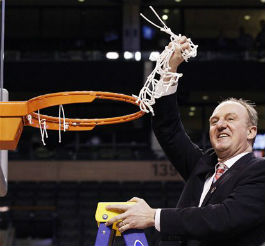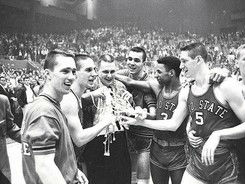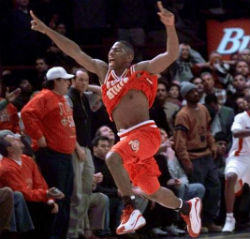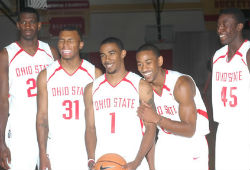 Thad Matta cuts down the net after OSU tops Syracuse
Thad Matta cuts down the net after OSU tops SyracuseOn Saturday evening the Ohio State Buckeyes will participate in their primetime match-up against the Kansas Jayhawks, marking the 11th unofficial (1999 vacated by NCAA) time the school has reached the prestigious level of the Final Four.
In their previous 10 trips, the Buckeyes have only taken home the crown of being college basketball's king just once, in 1960, while finishing as runner-up four other times (1939, 1961, 1962, and 2007) and failing to make it past the semi-finals the other five trips.
While winning Saturday alone will be a tough task, this OSU team is talented and special enough to get the university it's first hoops title in 52 years, but they will have to go through two very difficult opponents in Kansas and then either Louisville, or more likely, Kentucky.
The preview, breakdown, and look-ins to the match-up will come later this week, but before we can move forward with Thad Matta's team's quest to win the whole Big Dance, we must take a look back at the history books to see what went right, what went wrong, and what needs to be different this time around in Ohio State's previous trips to the big stage.
Join us after the jump as we travel back in time and get a look at the other great Buckeye teams that have gone where Jared Sullinger, Aaron Craft, and the rest of the 2011-2012 OSU men's basketball team will go this weekend.
Pre-Championship Era
The men's basketball team at Ohio State was formed in the late 1800's but it took until 1922 to win their first conference title and finally 1939, to reach their first Final Four.
 MOP Jimmy Hull looks on as Oregon takes the ring
MOP Jimmy Hull looks on as Oregon takes the ringThe 1939 team was lead by head coach Harold Olsen and featured all-conference selections in Bob Lynch and Jimmy Hull, who ended up as the tournament's Most Outstanding Player as he scored the most points during the tournament.
With a 64-52 victory over Wake Forest in the quarterfinals, the Bucks saw themselves in a semi-final match-up with the Wildcats of Villanova. In that game, Olsen's team moved one step closer to their first championship in school history, beating 'Nova easily by a score of 53-36 in Philadelphia.
After winning the Eastern Region, the Buckeyes found themselves squared up against the West winner, Oregon, in a match-up at Patten Gymnasium in Evanston, Illinois. The mighty Ducks lead by head coach Howard Hobson turned out to be too much for OSU, taking the Bucks down 46-33 and denying them the title.
It turns out 1939 was the best chance the university had for a while to win it all, as the Bucks did reach the Final Four again three years in a row from 1944-1946, but did not advance past the semi-finals in all three of those seasons.
In '44 it was Dartmouth who ended the Buckeyes' season by a score of 60-53, ending a great run by all-conference stars Arnold "Smokes" Risen and Don Grate. In '45 the Bucks were downed by NYU 70-65 in New York City and once again it was a Grate-lead team that came up short of championship dreams. Finally, finishing the trifecta, the '46 team lead by Jack Underman and Paul Huston that fell to North Carolina 60-57 in New York City once again.
Harold Olsen coached the team from 1923 until 1958, but was never able to get over the hump and win the big one for Ohio State. While they had some very good years throughout his tenure, it was time for a new sheriff in town to bring Columbus the championship and that's exactly what happened when Fred Taylor took over for Olsen in the 1959 season.
The Super 60's
It didn't take Fred Taylor much time to awake the sleeping giant that was Ohio State basketball. It also wasn't hard with the type of dream team he put together during the 1960's in Columbus.
 The '60 squad celebrates the school's only title
The '60 squad celebrates the school's only titleInheriting an 11-11 team before he was hired in the 1958-1959 season, it took Taylor just his second year to make the Buckeyes into a national power. The team finished 25-3 (13-1) on the season and was lead by All-American Jerry Lucas and star John Havlicek, both of who became eventual Hall-of-Famers, as well as Larry Siegfried, Mel Nowell, and some guy coming off the bench named Bob Knight.
Come tournament time it wasn't even a challenge for this rock star Buckeyes team as they steam rolled through Western Kentucky and Georgia Tech by an average margin of 18 points to advance to the Final Four for the first time in 14 years.
In the Final Four, the Bucks once again had their easy way with NYU, winning by 22 points and taking down California in the championship game at Cow Palace in Daly City, California by a score of 75-55 to give the program it's first and only national championship. The tournament MOP was Jerry Lucas, but the leading scorer was Oscar Robertson of semi-finalist Cincinnati, a team that would give Ohio State fits the next two seasons.
Taylor showed 1960 wasn't just a fluke as he took the Buckeyes back to the Final Four in 1961, 1962, and then again in 1968. Unfortunately for the beloved coach and the university, he was never ever to repeat the success he had in that second season, but he sure came close.
In 1961 the Buckeyes looked to be even better than they were the year before, going undefeated in the regular season. In the tournament the Bucks whizzed past Louisville and Kentucky to advance to their second straight Final Four, where they beat St. Joe's (PA) by 26 points to go to try and make it back-to-back titles for the school. Their opponent in the finals wasn't about to let that happen though as in-state rival Cincinnati awaited and was hungry to win their first school title after losing to California the year before.
Cincinnati was more than the Buckeyes could handle, giving Taylor's team their only loss of the season in the championship game by a score of 70-65. Jerry Lucas was once again named MOP of the tournament, but it was the Bearcats who denied the Bucks another championship.
In 1962 it was more of the same as OSU had just one regular season loss, won the Big Ten, and looked to be a national title contender for the third straight year.
The tournament brought easy wins against Western Kentucky and Kentucky in the Mideast region before the team downed Wake Forest 84-68 in the Final Four which was played in Freedom Hall at Louisville. In the other semi-final game, the UCLA Bruins and Cincinnati Bearcats met and fittingly enough, UC advanced to set up a rematch of the previous year's finals.
Once again Havlicek and Lucas were not enough to stop the mighty Bearcats and the Buckeyes fell 71-59. Lucas won his third straight MOP award, but it was Cincinnati who had multiple national titles and ended the star's career with a sour taste in his mouth.
After a five year drought of not making the national semi-finals, Taylor got the Buckeyes back to the promised land in 1968 and it would be the last time the school would get there until 1999 unofficially and 2007 officially.
The Buckeyes edged East Tennessee State and Kentucky in the Sweet 16 and Elite 8 to make it to Sports Arena in Los Angeles, California where they would battle with UNC, Houston, and UCLA to try to win their second title.
The Bucks drew the Tar Heels in the semi-finals but Bill Hosket and the boys didn't have enough juice in the tank to beat UNC, falling 80-66 before winning the third place game over Houston by a score of 89-85. While third place was nice finish Taylor wanted more and unfortunately the '68 season would be the last chance he would really get to bring Ohio State another championship trophy to St. John Arena.
The O'Brien Years
After Taylor retired in 1976, the Buckeyes went through coaches Eldon Miller, Gary Williams, and Randy Ayers before bringing in a guy named Jim O'Brien from Boston College in 1997, who was about to bring OSU back to where it belonged, at the top of college basketball.
 Scoonie celebrates the win* over St. John's in 1999
Scoonie celebrates the win* over St. John's in 1999O'Brien's first season in Columbus wasn't great to say the least, as his team went 8-22 and a school-worst 1-15 in the Big Ten Conference. It would be laughable to believe the Buckeyes would have a winning record during the 1998-1999 season, let alone contend for the national title, but that's exactly what they did.
Having a roster already with guard Michael Redd and big man Ken Johnson, O'Brien brought guard Scoonie Penn, who became the Big Ten Player of the Year that season, with him from BC to form a terrific trio in Columbus that lead the Bucks to a 23-8 record in the regular season where they earned a four-seed in the South region of the tournament.
OSU beat 13-seed Murray State by 14 before pounding 12-seed Detroit by 31 to advance to the Sweet 16. While getting to that level was impressive considering how the season before went, there were still plenty of skeptics out there as the school's two tournament wins came against weak opponents.
The Bucks were out to prove they were for real as they took down top seeded Auburn 72-63 and then third seeded St. John's in one of the more exciting games I ever watched, by a score of 77-74. The win against the Red Storm brought Ohio State back to the Final Four, a place they hadn't been since that 1968 season.
Unfortunately for O'Brien's team, their luck ran out and they had to face a team of destiny in Jim Calhoun's team that would eventually win the national championship. Redd's and Penn's magical year ended with a 64-58 loss to the Huskies in Tampa Bay, but the future looked bright for the Buckeyes who appeared to be climbing the ladder back towards the top of college basketball under their new coach.
Of course we know things didn't happen exactly like that as O'Brien was dismissed as head coach from the university in 2004 after it was discovered the coach loaned money to the mother of recruit Alex Radojevic, who never played for the school, as well as gave player Boban Savovic improper benefits while he was at the school from 1999-2002.
While this crippled the program at first, including a one year post-season ban, it may have been the best thing to ever happen to Ohio State basketball as athletic director Andy Geiger brought in Thad Matta to clean O'Brien's mess up and turn the program around.
Matta madness
Thad Matta came to Columbus with a track record of turning programs into winners, having lead Butler to a 24-8 record and the second round of the NCAA tournament, as well as taking Xavier to three 20-win seasons and an Elite Eight appearance.
 The Thad Five came up just short in '06-'07
The Thad Five came up just short in '06-'07Matta's task with the Buckeyes was not an easy one, but the coach didn't miss a step in his coaching career, leading OSU to a 20-12 season in his first year and piling up a 221-64 (.775) record at the school through today.
After winning the Big Ten in the first season he was eligible to, Matta had bigger plans for the Buckeyes in his second year. After bringing in a star laden recruiting class including the nation's top player in Greg Oden, as well as Mike Conley Jr., Daequan Cook, David Lighty, and, junior college stand out, Othello Hunter.
The "Thad Five" teamed with holdovers Jamal Butler, Ivan Harris, Ron Lewis, and Matt Terwilliger to lead the team to a 30-3 record entering the tournament as well as a top seed in the South Regional and the tournament's second overall seed.
In the post-season the Buckeyes had a few scares, including epic endings against Xavier in the second round and Tennessee in the Sweet 16, but battled through to reach the Final Four in Atlanta along with defending champion Florida, Georgetown, and UCLA.
In the national semi-final game against Georgetown the Buckeyes seemed like a team of destiny, taking down the Hoyas 67-60. The game was supposed to feature a match-up of giants in Oden and Roy Hibbert, but instead it was Mike Conley Jr. who stole the show and solidified himself as a top five pick in the NBA draft with 15 points, 5 rebounds, and 6 assists in a 39 minute masterpiece.
The Bucks then advanced to the championship to take on the defending champ Florida and nobody in the nation was really giving them a shot. It turned out the nation was right, as the veteran-lead Gators were just too much for the Buckeyes at the start and won in a closer than anticipated 84-75 game. Greg Oden emerged as the player everyone had been waiting for him to be all season long with 25 points, 12 rebounds, and 4 blocks, but once again Ohio State was denied it's second national championship.
Matta's story isn't just done yet, as he's done an outstanding job, keeping OSU at the top of the college basketball world since the 2007 national title game and has the Buckeyes back in the Final Four again this season. Beating Kansas and then Kentucky or Louisville is no easy task, but with a talented roster, some luck on their side, and a coach who has been there before, this could be the year Ohio State lands it's second title. Or, if history repeats itself, we may be waiting just a few more years.

